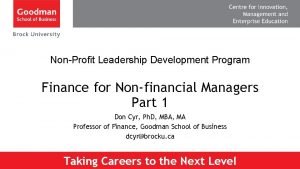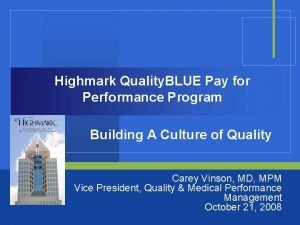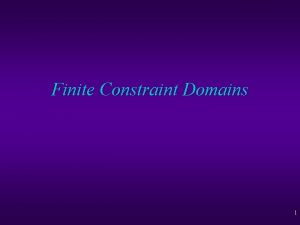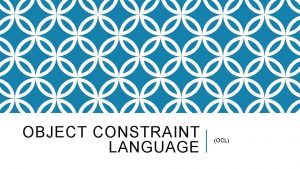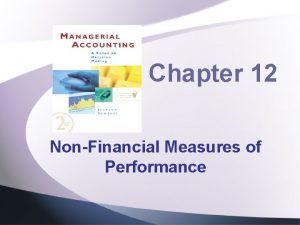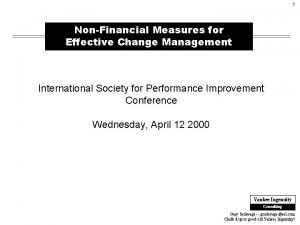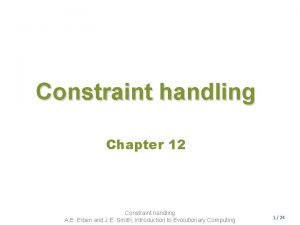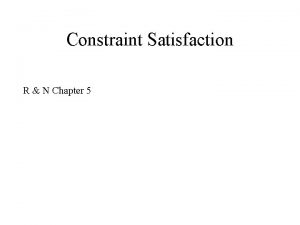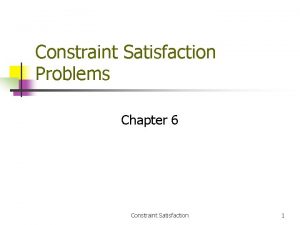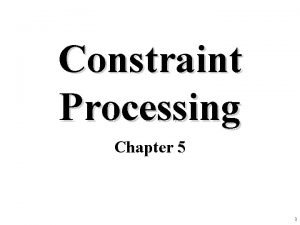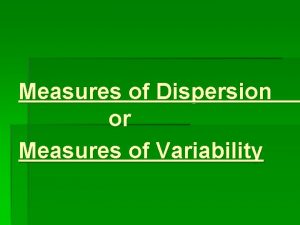QUALITY NONFINANCIAL MEASURES THEORY OF CONSTRAINT CHAPTER 19














- Slides: 14

QUALITY, NON-FINANCIAL MEASURES, THEORY OF CONSTRAINT CHAPTER 19

COST OF QUALITY • FOUR CATAGORIES – PREVENTION – APPRAISAL – INTERNAL FAILURE – EXTERNAL FAILURE • MEASURING EACH CATEGORY’S COST OF QUALITY HELPS DETERMINE WHERE EFFORT SHOULD BE APPLIED

TECHNIQUES TO ANALYZE QUALITY PROBLEMS • CONTROL CHARTS • PARETO DIAGRAMS • CAUSE AND EFFECT DIAGRAM

CONTROL CHARTS • Units Should Be 1 Inch Wide • 1 Standard deviation from the mean = ¼ in. • 2 std. devs. = ½ in. • 10 units produced of 1. 1 in, . 95 in, 1. 2 in, 1. 45 in, . 90 in, . 85 in, . 93 in, 1. 2 in, 1. 55 in, . 95 in,

PARETO DIAGRAM • You observe three errors in production: size, color, and texture. Out of 1, 000 units you observe the following errors: size 24; color 19; texture 13 • frequency • size • 25 • 20 • 15 • color texture type of error

Cause and Effect Diagram • During the month we found that defective units were caused by: • Lack of maintenance 10; operator inattention 13 Human Factor Operator Error - 13 23 Maintenance - 10 Machine-Related

NON-FINANCIAL MEASURES • THIS IS AN IMPORTANT MEASURE FOR ACCOUNTANTS TO GATHER AND REPORT • TWO SUCH MEASURES ARE QUALITY AND CUSTOMER SATISFACTION

EXAMPLE OF MEASURES • You produce prescription glasses • QUALITY MEASURES – Lenses reworked – Frames failing inspection CUSTOMER SATISFACTION MEASURES Number of customers who complain Delivery delays Defective units returned

EXERCISE • Fly-By-Night Airways is developing Nonfinancial measures of Quality and Customer Service • List some Quality Measures • List some Customer Service Measures

TIME DRIVERS AND COST OF TIME • Two cost drivers are • Uncertainty of customer orders and • Production capacity • Uncertainty of customer orders affects lead-time, i. e. , the AVERAGE WAITING TIME

AVERAGE WAITING TIME [ Average number of orders for product A 2 ( X [ -( Actual Capacity ) ]+[ Manufacturing time per order of product A 2 Average number of orders for product B ( X ) -( Average number Manufacturing of orders for X time per order product A of product A 2 )] Manufacturing time per order of product B Average number of orders for of product B X Manufacturing time per order product B )] If there is only one product, the formula is simplified by inserting zeroes in the elements of the second product. If there are more than two products, simply insert a third element consistent with the first two. NOTICE that the numerator is related to the production time of a product and the denominator is simply two times excess capacity.

EFFECTS OF INCREASED WAITING TIME • REVENUES – We may not be able to charge the same price if the customer has to wait, i. e. , higher sales price for faster delivery. • COSTS – We may incur higher carrying costs of inventory if there is a greater wait period for materials to be put into production, e. g. , more storage, more capital costs, more insurance

THEORY OF CONSTRAINTS (TOC) • Determine where constraints (bottlenecks) occur and deal with them, not with other parts of the production • Example: Our production goes through machines A, with a production rate of 60 units per hour, and then machine B, with a production rate of 100 units per hour. We can purchase a new machine B that will produce 130 units per hour at a very good price. Should we spend much time analyzing this option? • NO. Replacing machine B will probably not increase production, the constraint is machine A.

TOC EXERCISES • WHERE WERE THE CONSTRAINTS THE LAST TIME YOU FLEW? • WHERE ARE THE TRAFFIC CONSTRAINTS WHEN YOU DRIVE TO CAMPUS? • WHERE ARE THE CONSTRAINTS AT THE STUDENT UNION’S FOOD SERVICE?
 Wharton finance for nonfinancial managers
Wharton finance for nonfinancial managers Anova repeated measures
Anova repeated measures Ccbhc quality measures
Ccbhc quality measures Highmarl true performance quality measures
Highmarl true performance quality measures Cmmi oncology care model
Cmmi oncology care model Amy bassano cms
Amy bassano cms Perform quality assurance
Perform quality assurance Pmp quality management
Pmp quality management Pmbok quality management
Pmbok quality management Quality assurance model in nursing management
Quality assurance model in nursing management Compliance vs quality
Compliance vs quality Basic concepts of quality control
Basic concepts of quality control Known as the fun uncle of the quality revolution
Known as the fun uncle of the quality revolution Quality is free
Quality is free What is tqm
What is tqm
